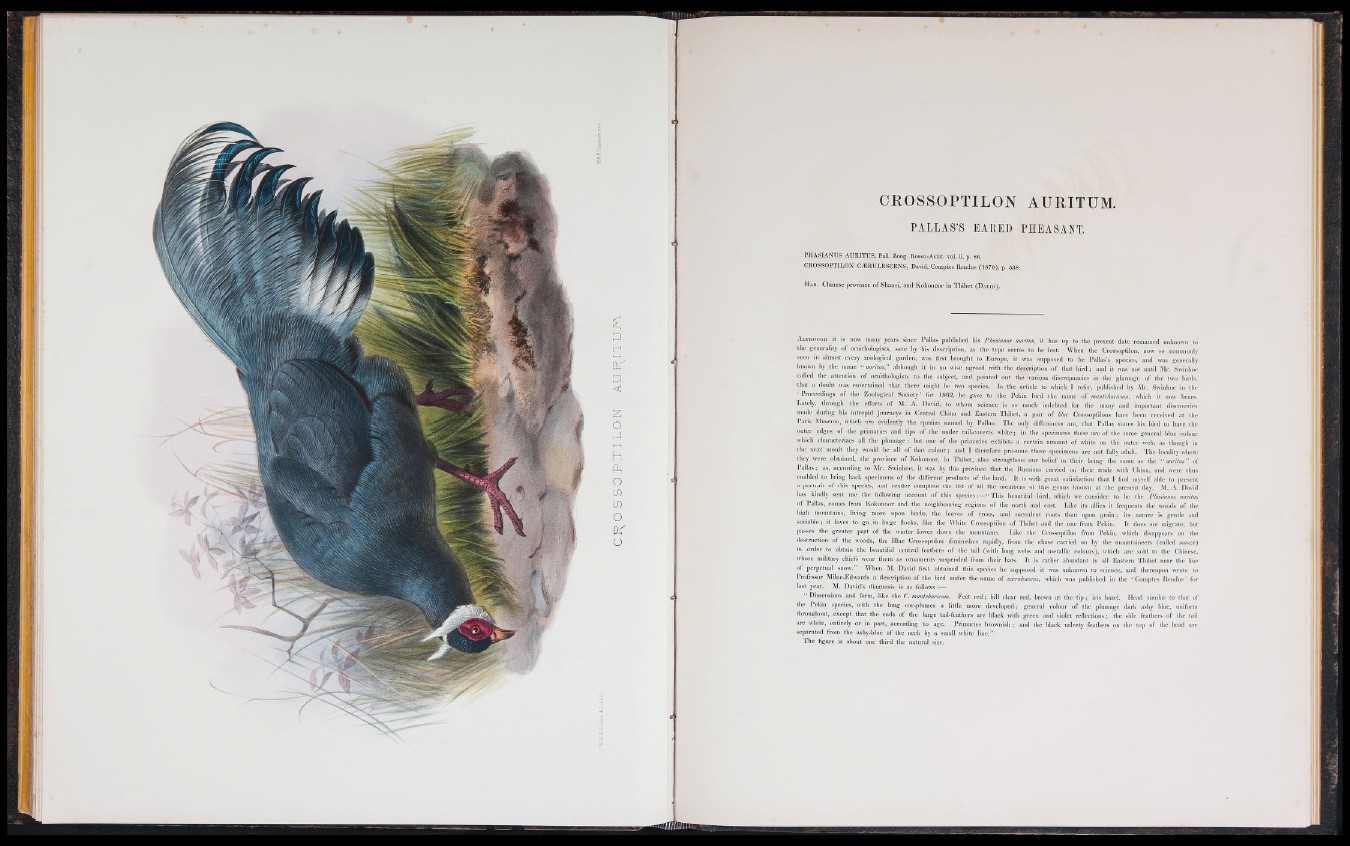
CT^O S S OPT LON At F ( ITUivY
CROSSOPTILON AURITUM.
P A L LA S® EARED PHEASANT.
PHASIANUS AURITUS, Pall. Zoog. Rosso-Asiat. vol. ii. p. 86.
CROSSOPTILON CLERULESCENS, David, Comptes Rendus (1 8 7 0 ), p. 538.
Hab. Chinese province of Shansi, and Kokonoor in Thibet (D avid) .
A l th o u g h it is now many years sineg , Pallas published his Phasiantts auriius, it has up to the present date remained unknown to
the generality of ornithologists, save by his description, as the type seems to be lost. When the Crossoptilon, now so commonly
seen in .almost every zoological garden, was first brought to Europe, it was supposed to be Pallas’s species, and was generally
known by the name "auriius,” although it in no wise agreed with the description o f that b ird ; and it was not until Mr. Swinhoe
called the attention of ornithologists to the subject, and pointed out the "various discrepancies in 'th e plumage of the two birds,
that a doubt was entertained that there might be two species. In ¿he article to which I refer, published by Mr. Swinhoe in the
‘ Proceedings of the Zoological Society ’ for 1862, he gave^to the Pekin bird the name of mantchuricum, which it now bears.
Lately, through the efforts o f M. A. D a v id ,'to whom science is so much indebted for the many and important discoveries
made during his intrepid journeys in Central' Chinp and Eastern Thibet, a pair o f blue Crossoptilons have been received at the
Paris Museum, which are evidently the species, named by Pallas. The only differences are, that Pallas states his.bird to have the
outer edges of the primaries and tips of the under tail-coverts. white; in the specimens these are of the same general blue colour
which' Characterizes all the plumage: but one of the primaries exhibits a certain amount of white on the outer web, as though in
the next moult they would be all o f that colour; and I therefore presume these specimens are not fully adult. The locality where
they were obtained, the province o f Kokonoor, in Thibet, also strengthens our belief in their being the same as the “ auriius” of
Pallas; as, according to Mr. Swinhoe, it was by this province that the Russians carried on their trade with China, and were thus
enabled to bring back specimens of the different products of the land. It is with great satisfaction that I find myself able to present
a portrait of this species, and render complete the list of all the members , o f this genus known a t the present day. M. A. David
has kindly sent me the following account of this species:—“ This beautiful bird, which we consider to be the Phasianus auriius
o f Pallas, comes from Kokonoor and the neighbouring regions of the north and east. Like its allies it frequents the woods o f the
high mountains, living more upon herbs, the leaves o f trees, and succulent roots than upon g ra in ; its nature is gentle and
sociable ; it loves to go in large flocks, like the White Crossoptilon of Thibet and the one from Pekin. It does not migrate, but
passes the greater part of the winter lower down the mountains. Like tile Crossoptilon from Pekin, which disappears on the
destruction of the woods, the Blue Crossoptilon diminishes rapidly, from the cha\e carried on by the mountaineers (called mauze)
in order to obtain the beautiful central, feathers o f the tail (with long webs and metallic coloui’s), which are sold to the Chinese,
whose military chiefs wear them as ornaments suspended from their hats. I t is rather abundant in all Eastern Thibet near the line
of perpetual snow.” When M. David first obtained this species he supposed it was unknown to science, and thereupon wrote to
Professor Milne-Edwards a description of the bird under the name of cterulescens, which was published in the * Comptes Rendus ’ for
last year. M. David’s diagnosis is as follows
“ Dimensions and form, like the C. mantchuricum. Feet re d ; bill clear red, brown a t the tip ; iris hazel. Head similar to that of
the Pekin species, with the long ear-plumes a little more developed; general colour o f the plumage dark ashy blue, uniform
throughout, except that the ends of the large tail-feathers are black with green and violet reflections;.;, the side feathers of the tail
are white, entirely or in part, according to age. Primaries brownish; and the black velvety feathers on the top o f the head are
separated from the ashy-blue of the neck by a small white line,”